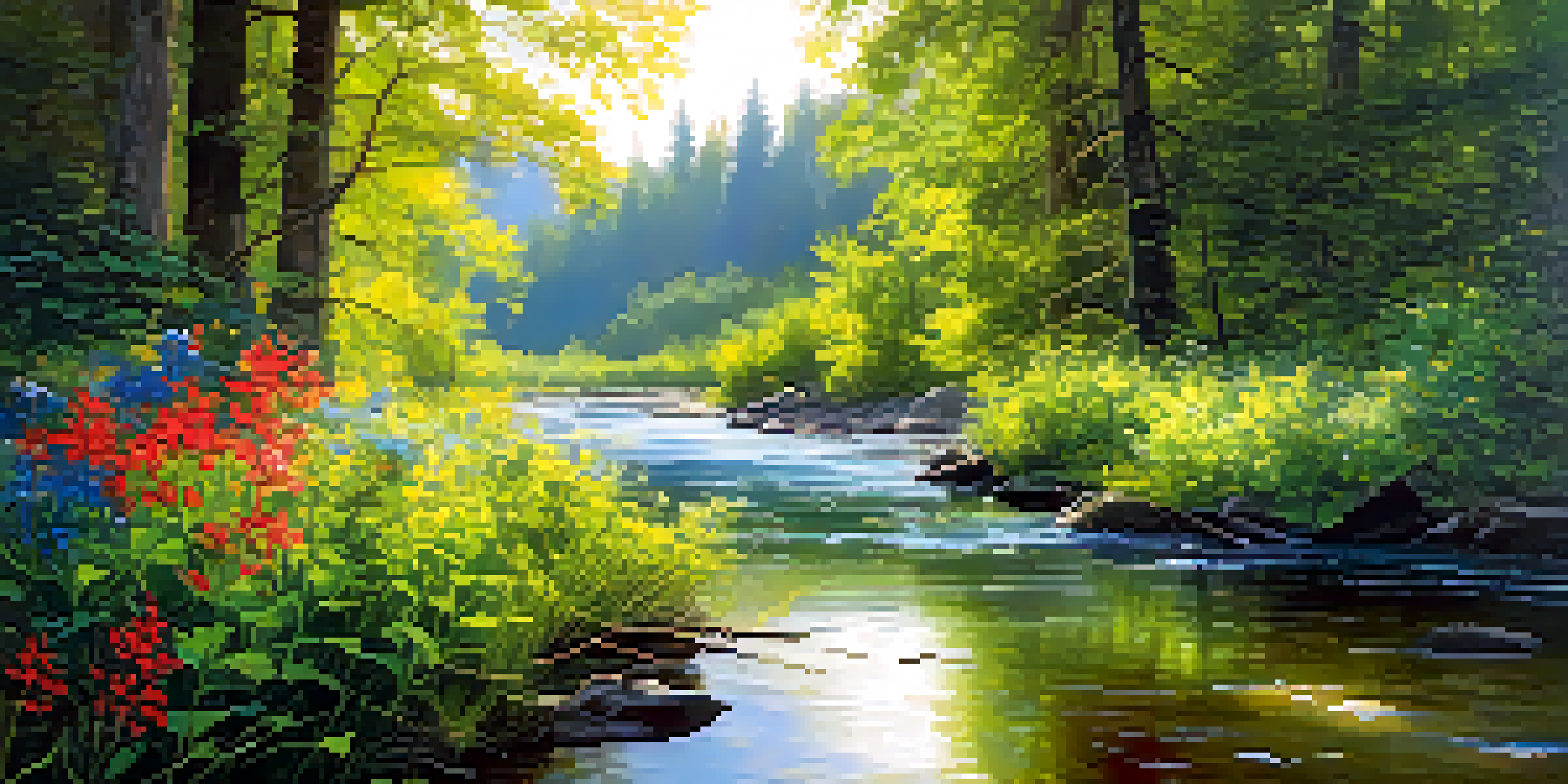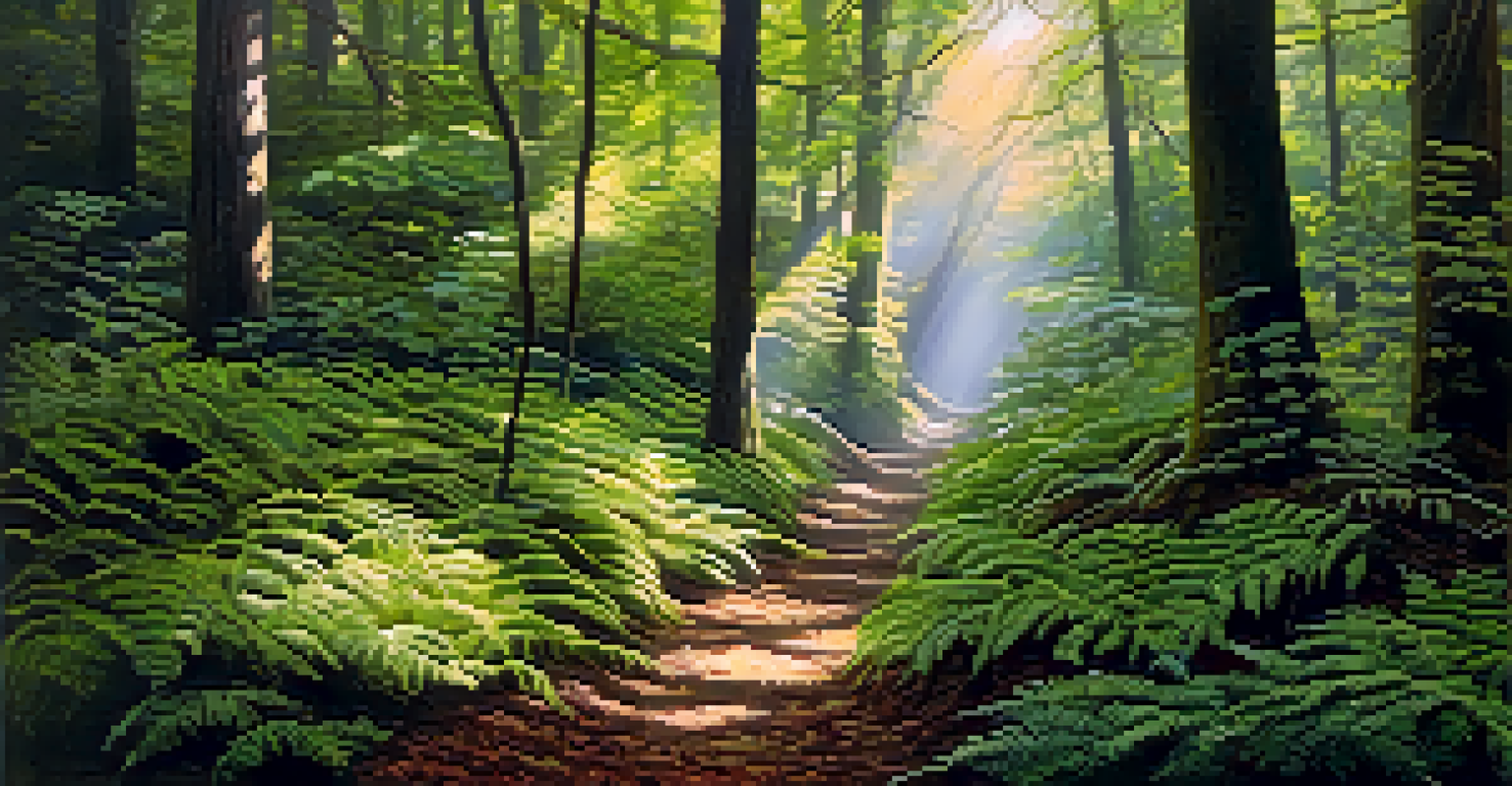Nature as a Spiritual Guide in Transcendentalist Art

Understanding Transcendentalism and Its Roots
Transcendentalism emerged in the early 19th century as a philosophical movement that emphasized the intrinsic goodness of people and nature. Central figures like Ralph Waldo Emerson and Henry David Thoreau sought to transcend the material world and connect with a deeper spiritual essence. This movement was heavily influenced by Romanticism, which celebrated emotion, individualism, and the sublime beauty of the natural world.
In the presence of nature, a wild delight runs through the man, in spite of real sorrows.
At its core, transcendentalism posits that true understanding and insight come from personal intuition rather than societal norms. This belief often leads individuals to seek solace and inspiration in nature, viewing it as a mirror reflecting their inner spiritual journey. Nature becomes not just a backdrop but a vibrant participant in the quest for self-discovery and enlightenment.
In this light, transcendentalist art serves as a visual representation of these ideals, inviting viewers to explore their own connections with the natural world. Artists like Thomas Cole and Frederic Edwin Church captured the grandeur of landscapes, encouraging contemplation and a sense of awe that transcends everyday life.
Nature as a Source of Spiritual Awakening
Transcendentalists viewed nature as a vital source of spiritual awakening, believing that it could guide individuals toward a higher understanding of themselves and the universe. This perspective is beautifully illustrated in Thoreau's 'Walden,' where he describes his experiment in simple living amidst the woods. For Thoreau, immersing himself in nature was a path to discovering profound truths about existence and the self.

The beauty and complexity of nature often serve as catalysts for introspection, prompting individuals to reflect on their place within the larger tapestry of life. The changing seasons, the growth of trees, and the cycles of wildlife all symbolize transformation and renewal. By observing these processes, transcendentalists found inspiration for their own spiritual journeys, reinforcing the interconnectedness of all living things.
Nature as a Spiritual Guide
Transcendentalists believed that nature serves as a vital source of spiritual awakening, guiding individuals toward deeper self-understanding.
Artistic representations of nature, featuring lush landscapes and serene settings, evoke feelings of peace and contemplation. These works not only celebrate the beauty of the natural world but also encourage viewers to engage with their own spiritual quests, fostering a deeper appreciation for both art and nature.
Symbolism and Imagery in Transcendentalist Art
The use of symbolism in transcendentalist art is crucial for conveying deeper spiritual meanings. Artists often employed natural elements like rivers, mountains, and skies to symbolize broader concepts such as freedom, the passage of time, and the infinite. For example, a flowing river might represent the journey of life, while majestic mountains could signify lofty aspirations or the divine.
I went to the woods because I wished to live deliberately, to front only the essential facts of life.
This rich imagery invites viewers to not only admire the art but also to explore their interpretations and emotional responses. Each brushstroke can evoke a sense of wonder, prompting reflections on personal experiences and beliefs. As viewers engage with these symbols, they find a means to connect their own spiritual journeys with those of the artists.
Moreover, the settings depicted in transcendentalist art often reflect the artists' reverence for nature as a spiritual guide. These visual representations create a space for contemplation, allowing individuals to step away from the chaos of modern life and reconnect with the tranquility that nature offers.
The Role of Intuition in Artistic Expression
Intuition is a cornerstone of both transcendentalism and its artistic expressions. Artists believed that tapping into their inner feelings and instincts could lead to more authentic representations of nature and spirituality. This approach often resulted in artworks that resonate on a deeper emotional level, as they reflect the artists' personal experiences and insights.
For instance, Emerson championed the idea that true art emerges from the artist's ability to connect with their intuition rather than conforming to established rules or societal expectations. This philosophy encouraged artists to embrace spontaneity and authenticity, resulting in works that were not only visually stunning but also rich in meaning.
Art Reflects Intuition and Emotion
Transcendentalist art emphasizes intuition and personal experience, inviting viewers to connect emotionally with the natural world.
As viewers engage with these intuitive expressions, they are invited to explore their own feelings and insights. This shared connection fosters a sense of unity between the viewer, the artist, and the natural world, creating a space where spiritual growth can flourish.
Nature's Healing Power in Transcendentalism
Transcendentalists believed in the healing power of nature, viewing it as a refuge from the stresses of urban life and societal pressures. Thoreau famously retreated to the woods to find solace and clarity, illustrating how nature can provide a nurturing environment for personal and spiritual growth. This belief in nature's restorative qualities is a recurring theme in both literature and art from the era.
Artists often depicted serene natural landscapes that evoke feelings of calm and tranquility. These beautiful portrayals not only celebrate the aesthetic qualities of nature but also serve as reminders of its ability to heal and rejuvenate the spirit. By immersing themselves in these representations, viewers can experience a sense of peace and reflection, much like the artists did in their own encounters with nature.
This connection between nature and healing underscores the transcendentalist belief that being in touch with the natural world can lead to profound personal transformations. The artworks serve as a visual invitation to embrace nature as a source of strength and renewal.
The Influence of Nature on Modern Spiritual Practices
The transcendentalist idea of nature as a spiritual guide continues to influence modern spiritual practices. Today, many people turn to nature for inspiration, meditation, and mindfulness, echoing the sentiments of figures like Emerson and Thoreau. Outdoor retreats and nature-based workshops have gained popularity as individuals seek to reconnect with their inner selves through the natural world.
In contemporary art, we see a resurgence of themes that celebrate nature as a spiritual entity. Artists draw on the same principles that guided transcendentalists, creating works that invite viewers to reflect on their relationships with both nature and spirituality. This ongoing dialogue between art and nature reinforces the timeless relevance of transcendentalist ideas.
Modern Practices Echo Transcendentalism
The principles of transcendentalism continue to influence contemporary spiritual practices, encouraging people to seek inspiration and mindfulness in nature.
As people navigate the complexities of modern life, the lessons from transcendentalism remind us of the importance of slowing down and finding solace in the natural world. Whether through art, meditation, or simply spending time outdoors, individuals are encouraged to explore the profound connections between nature and their own spiritual journeys.
Embracing Nature's Wisdom in Our Lives
Embracing nature's wisdom is not just a theme in art; it can be a guiding principle in our daily lives. By taking time to appreciate the natural world around us, we open ourselves to insights and experiences that can enrich our understanding of life. Simple acts like walking in a park or observing a sunset can provoke thoughts and feelings that lead to personal growth.
Transcendentalism teaches us to value our inner experiences and the lessons nature offers. It encourages us to cultivate a sense of wonder and gratitude for the beauty that surrounds us. By engaging with nature, we can find clarity and inspiration, helping us navigate our own paths in life.

Ultimately, the teachings of transcendentalism remind us that nature is not just a backdrop for our existence but a vital partner in our spiritual journeys. By embracing its wisdom, we can foster a deeper connection with ourselves and the world around us, encouraging a more mindful and fulfilling life.